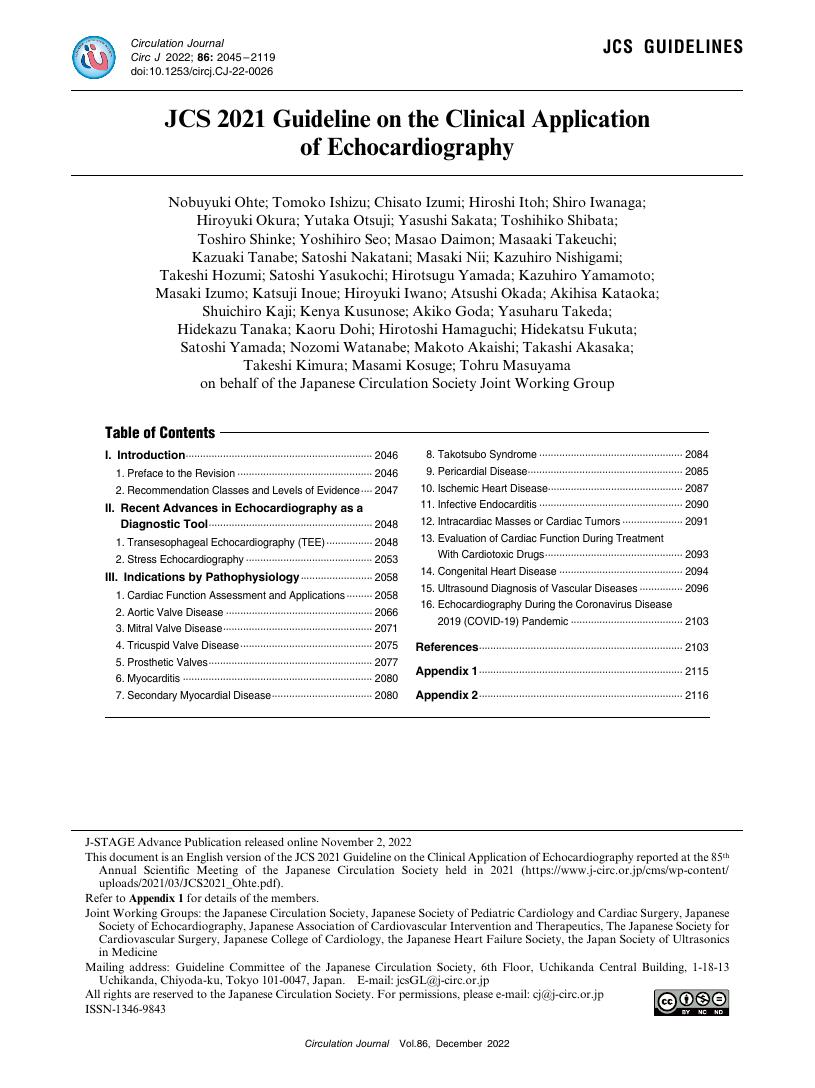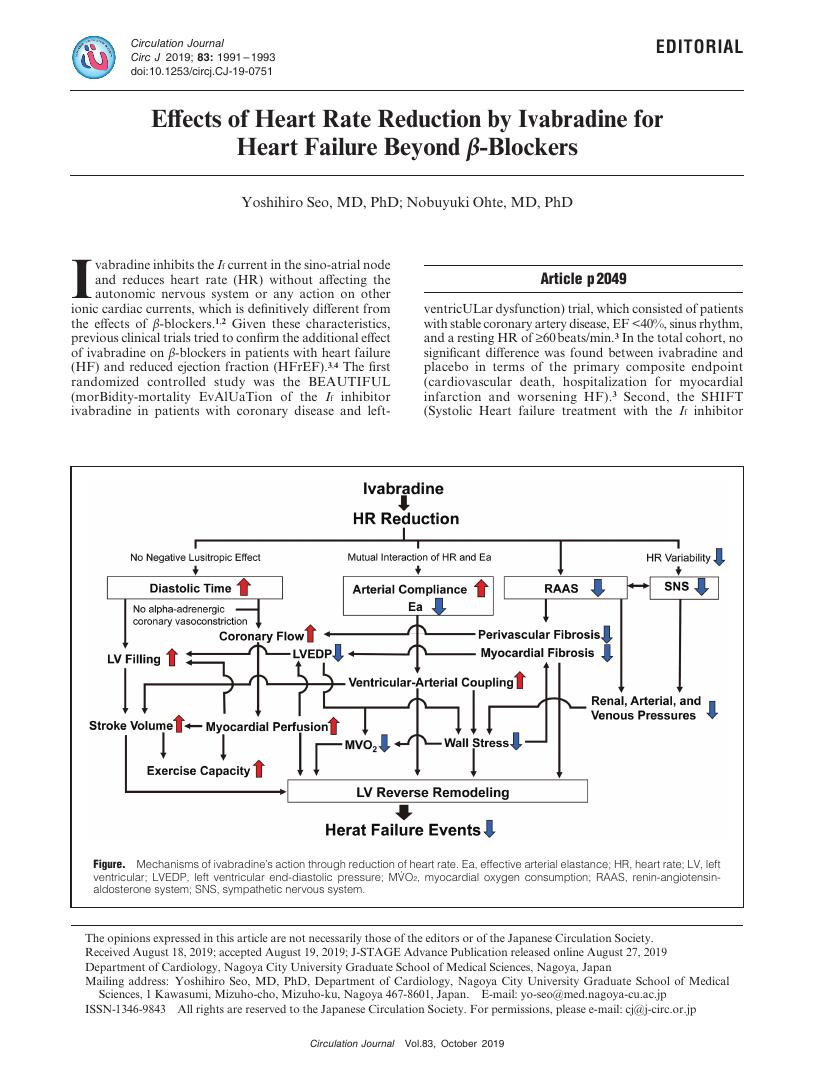- 著者
- Akihiko Nogami Takashi Kurita Haruhiko Abe Kenji Ando Toshiyuki Ishikawa Katsuhiko Imai Akihiko Usui Kaoru Okishige Kengo Kusano Koichiro Kumagai Masahiko Goya Yoshinori Kobayashi Akihiko Shimizu Wataru Shimizu Morio Shoda Naokata Sumitomo Yoshihiro Seo Atsushi Takahashi Hiroshi Tada Shigeto Naito Yuji Nakazato Takashi Nishimura Takashi Nitta Shinichi Niwano Nobuhisa Hagiwara Yuji Murakawa Teiichi Yamane Takeshi Aiba Koichi Inoue Yuki Iwasaki Yasuya Inden Kikuya Uno Michio Ogano Masaomi Kimura Shun-ichiro Sakamoto Shingo Sasaki Kazuhiro Satomi Tsuyoshi Shiga Tsugutoshi Suzuki Yukio Sekiguchi Kyoko Soejima Masahiko Takagi Masaomi Chinushi Nobuhiro Nishi Takashi Noda Hitoshi Hachiya Masataka Mitsuno Takeshi Mitsuhashi Yasushi Miyauchi Aya Miyazaki Tomoshige Morimoto Hiro Yamasaki Yoshifusa Aizawa Tohru Ohe Takeshi Kimura Kazuo Tanemoto Hiroyuki Tsutsui Hideo Mitamura on behalf of the JCS/JHRS Joint Working Group
- 出版者
- The Japanese Circulation Society
- 雑誌
- Circulation Journal (ISSN:13469843)
- 巻号頁・発行日
- pp.CJ-20-0637, (Released:2021-06-01)
- 参考文献数
- 1350
- 被引用文献数
- 75
- 著者
- Tatsuya Mizoguchi Tomonori Sugiura Yu Kawada Junki Yamamoto Masashi Yokoi Kosuke Nakasuka Kento Mori Shohei Kikuchi Tsuyoshi Ito Shuichi Kitada Toshihiko Goto Yoshihiro Seo
- 出版者
- The Japanese Circulation Society
- 雑誌
- Circulation Journal (ISSN:13469843)
- 巻号頁・発行日
- pp.CJ-22-0772, (Released:2023-03-21)
- 参考文献数
- 46
Background: The number of patients with heart failure (HF) has increased, and it is crucial to prevent the development of HF in patients at risk of HF. The present study aimed to risk stratify patients in Stage A and B HF based on associations between exercise-induced changes in aortic stiffness and exercise tolerance.Methods and Results: Patients in Stage A and B HF who performed a cardiopulmonary exercise test were enrolled in the study (n=106; median age 65.0 years [interquartile range 52.8–73.0 years]). Exercise tolerance was examined by the percentage of predicted peak oxygen consumption (%V̇O2peak). The ascending aortic pressure waveform was estimated non-invasively. Aortic stiffness was assessed using the augmentation index (AIx) and reflection magnitude (RM). Multivariable regression analysis showed that AIx measured both before and after exercise was significantly associated with %V̇O2peak (β=−0.221 [P=0.049] and β=−0.342 [P=0.003], respectively). When participants were divided into %V̇O2peak subgroups using a cut-off value of 60%, RM decreased immediately after exercise and remained lower 5 min after exercise in the group with preserved exercise tolerance, but recovered to baseline levels 5 min after exercise in the group with reduced exercise tolerance.Conclusions: Exercise-induced increases in aortic stiffness were associated with exercise tolerance in patients at risk of HF, suggesting that exercise-induced changes in aortic stiffness may be useful to stratify high-risk patients.
- 著者
- Shohei Kikuchi Yoshihiro Seo
- 出版者
- The Japanese Circulation Society
- 雑誌
- Circulation Journal (ISSN:13469843)
- 巻号頁・発行日
- pp.CJ-23-0521, (Released:2023-08-10)
- 参考文献数
- 14
- 著者
- Nobuyuki Ohte Tomoko Ishizu Chisato Izumi Hiroshi Itoh Shiro Iwanaga Hiroyuki Okura Yutaka Otsuji Yasushi Sakata Toshihiko Shibata Toshiro Shinke Yoshihiro Seo Masao Daimon Masaaki Takeuchi Kazuaki Tanabe Satoshi Nakatani Masaki Nii Kazuhiro Nishigami Takeshi Hozumi Satoshi Yasukochi Hirotsugu Yamada Kazuhiro Yamamoto Masaki Izumo Katsuji Inoue Hiroyuki Iwano Atsushi Okada Akihisa Kataoka Shuichiro Kaji Kenya Kusunose Akiko Goda Yasuharu Takeda Hidekazu Tanaka Kaoru Dohi Hirotoshi Hamaguchi Hidekatsu Fukuta Satoshi Yamada Nozomi Watanabe Makoto Akaishi Takashi Akasaka Takeshi Kimura Masami Kosuge Tohru Masuyama on behalf of the Japanese Circulation Society Joint Working Group
- 出版者
- The Japanese Circulation Society
- 雑誌
- Circulation Journal (ISSN:13469843)
- 巻号頁・発行日
- vol.86, no.12, pp.2045-2119, 2022-11-25 (Released:2022-11-25)
- 参考文献数
- 460
- 被引用文献数
- 16
- 著者
- Masayoshi Yamamoto Yoshihiro Seo Tomoko Ishizu Isao Nishi Yoshie Hamada-Harimura Tomoko Machino-Ohtsuka Kimi Sato Seika Sai Akinori Sugano Kenichi Obara Kazutaka Aonuma
- 出版者
- 日本循環器学会
- 雑誌
- Circulation Journal (ISSN:13469843)
- 巻号頁・発行日
- pp.CJ-17-0240, (Released:2017-06-06)
- 参考文献数
- 27
- 被引用文献数
- 9
Background:Although experimental animal studies report many pleiotropic effects of dipeptidyl peptidase-4 inhibitors (DPP-4i), their prognostic value has not been demonstrated in clinical trials.Methods and Results:Among 838 prospectively enrolled heart failure (HF) patients hospitalized for acute decompensated HF, 79 treated with DPP-4i were compared with 79 propensity score-matched non-DPP-4i diabetes mellitus (DM) patients. The primary endpoint was all-cause mortality; the secondary endpoint was a composite of cardiovascular death and hospitalization. During follow-up (423±260 days), 8 patients (10.1%) in the DPP-4i group and 13 (16.5%) in the non-DPP-4i group died (log-rank, P=0.283). The DPP-4i group did not have a significantly higher rate of all-cause mortality (log-rank, P=0.283), or cardiovascular death or hospitalization (log-rank, P=0.425). In a subgroup analysis of HF with preserved ejection fraction (HFpEF; n=75), the DPP-4i group had a significantly better prognosis than the non-DPP-4i group regarding the primary endpoint (log-rank, P=0.021) and a tendency to have better prognosis regarding the secondary endpoint (log-rank, P=0.119). In patients with HF with reduced EF (n=83), DPP-4i did not result in better prognosis.Conclusions:DPP-4i did not increase the risk of adverse clinical outcomes in patients with DM and HF. DPP-4i may be beneficial in HFpEF.
- 著者
- Tomofumi Nakatsukasa Tomoko Ishizu Masumi Ouchi Nobuyuki Murakoshi Kimi Sato Masayoshi Yamamoto Kunio Kawanishi Yoshihiro Seo Masaki Ieda
- 出版者
- The Japanese Circulation Society
- 雑誌
- Circulation Journal (ISSN:13469843)
- 巻号頁・発行日
- vol.86, no.12, pp.2029-2039, 2022-11-25 (Released:2022-11-25)
- 参考文献数
- 35
- 被引用文献数
- 4
Background: Elevated central venous pressure (CVP) in heart failure causes renal congestion, which deteriorates prognosis. Sodium glucose co-transporter 2 inhibitor (SGLT2-i) improves kidney function and heart failure prognosis; however, it is unknown whether they affect renal congestion. This study investigated the effect of SGLT2-i on the kidney and left ventricle using model rats with hypertensive heart failure.Methods and Results: Eight rats were fed a 0.3% low-salt diet (n=7), and 24 rats were fed an 8% high-salt diet, and they were divided into 3 groups of untreated (n=6), SGLT2-i (canagliflozin; n=6), and loop diuretic (furosemide; n=5) groups after 11 weeks of age. At 18 weeks of age, CVP and renal intramedullary pressure (RMP) were monitored directly by catheterization. We performed contrast-enhanced ultrasonography to evaluate intrarenal perfusion. In all high-salt fed groups, systolic blood pressure was elevated (P=0.287). The left ventricular ejection fraction did not differ among high-salt groups. Although CVP decreased in both the furosemide (P=0.032) and the canagliflozin groups (P=0.030), RMP reduction (P=0.003) and preserved renal medulla perfusion were only observed in the canagliflozin group (P=0.001). Histological analysis showed less cast formation in the intrarenal tubule (P=0.032), left ventricle fibrosis (P<0.001), and myocyte thickness (P<0.001) in the canagliflozin group than in the control group.Conclusions: These results suggest that SGLT2-i causes renal decongestion and prevents left ventricular hypertrophy, fibrosis, and dysfunction
- 著者
- Tomonori Sugiura Yasuaki Dohi Yasuyuki Takagi Takashi Yokochi Naofumi Yoshikane Kenji Suzuki Takamasa Tomiishi Takashi Nagami Mitsunori Iwase Hiroyuki Takase Nobuyuki Ohte Yoshihiro Seo
- 出版者
- Japan Atherosclerosis Society
- 雑誌
- Journal of Atherosclerosis and Thrombosis (ISSN:13403478)
- 巻号頁・発行日
- pp.63368, (Released:2022-02-03)
- 参考文献数
- 49
- 被引用文献数
- 5
Aims: Serum uric acid increases with metabolic disorders; however, whether the effects of uric acid on atherosclerosis are different in females and males has not been sufficiently evaluated. Therefore, this study compared the impact of uric acid on arterial stiffness and atherosclerosis between females and males. Methods: We enrolled 10196 untreated middle-aged subjects (46±8 years, 3021 females and 7175 males) who underwent periodic health check-ups. Serum uric acid levels were measured and arterial stiffness and atherosclerosis were assessed by the cardio-ankle vascular index (CAVI), carotid intima-media thickness (IMT), and plaque, using ultrasound imaging. Results: Females with increased arterial stiffness (CAVI ≥ 8.0) or carotid plaques had higher uric acid than those without (P<0.0001), but males did not. In multivariable regression analyses including overall participants, uric acid was significantly associated with the CAVI, where sex interacted with uric acid. In sex-specific analyses, uric acid was significantly associated with the CAVI, but not with carotid IMT, in both sexes. However, logistic regression analyses revealed that serum uric acid was independently associated with the presence of carotid plaques in females. The exclusion of subjects with abdominal obesity or metabolic syndrome from the analysis did not alter the results in females. Conclusions: Serum uric acid was significantly associated with the CAVI in both sexes, but the interaction of sex was confirmed and associated with a carotid plaque only in females. These findings support the increased impact of serum uric acid on arterial stiffness and atherosclerosis in females.
- 著者
- Yoshihiro Seo Nobuyuki Ohte
- 出版者
- The Japanese Circulation Society
- 雑誌
- Circulation Journal (ISSN:13469843)
- 巻号頁・発行日
- vol.83, no.10, pp.1991-1993, 2019-09-25 (Released:2019-09-25)
- 参考文献数
- 15
- 被引用文献数
- 3
1 0 0 0 OA Report of the American Heart Association (AHA) Scientific Session 2017, Anaheim, California
- 著者
- Yoshihiro Seo
- 出版者
- The Japanese Circulation Society
- 雑誌
- Circulation Journal (ISSN:13469843)
- 巻号頁・発行日
- pp.CJ-17-1387, (Released:2018-01-11)
- 参考文献数
- 14
- 被引用文献数
- 2
On November 11–15, the American Heart Association (AHA) Scientific Sessions 2017 were held in Anaheim, California, for the first time in 16 years. The annual sessions attracted nearly 18,000 attendees, with a global presence from more than 100 countries, and featured 5 days of programming for cardiovascular basic scientists, clinicians, and researchers. As usual, activities of participants from Japan were prominent. From the exciting sessions, I report the topics and key presentations including the late-breaking clinical trials.
- 著者
- Masayoshi Yamamoto Yoshihiro Seo Tomoko Ishizu Isao Nishi Yoshie Hamada-Harimura Tomoko Machino-Ohtsuka Kimi Sato Seika Sai Akinori Sugano Kenichi Obara Kazutaka Aonuma
- 出版者
- 日本循環器学会
- 雑誌
- Circulation Journal (ISSN:13469843)
- 巻号頁・発行日
- vol.81, no.11, pp.1662-1669, 2017-10-25 (Released:2017-10-25)
- 参考文献数
- 27
- 被引用文献数
- 9
Background:Although experimental animal studies report many pleiotropic effects of dipeptidyl peptidase-4 inhibitors (DPP-4i), their prognostic value has not been demonstrated in clinical trials.Methods and Results:Among 838 prospectively enrolled heart failure (HF) patients hospitalized for acute decompensated HF, 79 treated with DPP-4i were compared with 79 propensity score-matched non-DPP-4i diabetes mellitus (DM) patients. The primary endpoint was all-cause mortality; the secondary endpoint was a composite of cardiovascular death and hospitalization. During follow-up (423±260 days), 8 patients (10.1%) in the DPP-4i group and 13 (16.5%) in the non-DPP-4i group died (log-rank, P=0.283). The DPP-4i group did not have a significantly higher rate of all-cause mortality (log-rank, P=0.283), or cardiovascular death or hospitalization (log-rank, P=0.425). In a subgroup analysis of HF with preserved ejection fraction (HFpEF; n=75), the DPP-4i group had a significantly better prognosis than the non-DPP-4i group regarding the primary endpoint (log-rank, P=0.021) and a tendency to have better prognosis regarding the secondary endpoint (log-rank, P=0.119). In patients with HF with reduced EF (n=83), DPP-4i did not result in better prognosis.Conclusions:DPP-4i did not increase the risk of adverse clinical outcomes in patients with DM and HF. DPP-4i may be beneficial in HFpEF.

